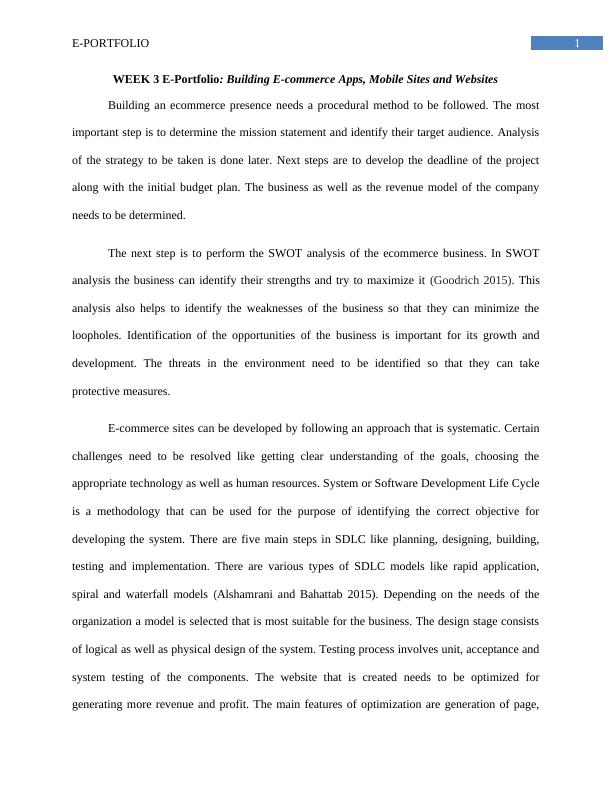Concepts and Business Modules of E-Commerce
18 Pages4010 Words40 Views
Added on 2020-02-19
Concepts and Business Modules of E-Commerce
Added on 2020-02-19
ShareRelated Documents
Running head: E-PORTFOLIOE-PortfolioName of the StudentName of the UniversityAuthor’ s note

1E-PORTFOLIOWEEK 3 E-Portfolio: Building E-commerce Apps, Mobile Sites and WebsitesBuilding an ecommerce presence needs a procedural method to be followed. The mostimportant step is to determine the mission statement and identify their target audience. Analysisof the strategy to be taken is done later. Next steps are to develop the deadline of the projectalong with the initial budget plan. The business as well as the revenue model of the companyneeds to be determined. The next step is to perform the SWOT analysis of the ecommerce business. In SWOTanalysis the business can identify their strengths and try to maximize it (Goodrich 2015). Thisanalysis also helps to identify the weaknesses of the business so that they can minimize theloopholes. Identification of the opportunities of the business is important for its growth anddevelopment. The threats in the environment need to be identified so that they can takeprotective measures. E-commerce sites can be developed by following an approach that is systematic. Certainchallenges need to be resolved like getting clear understanding of the goals, choosing theappropriate technology as well as human resources. System or Software Development Life Cycleis a methodology that can be used for the purpose of identifying the correct objective fordeveloping the system. There are five main steps in SDLC like planning, designing, building,testing and implementation. There are various types of SDLC models like rapid application,spiral and waterfall models (Alshamrani and Bahattab 2015). Depending on the needs of theorganization a model is selected that is most suitable for the business. The design stage consistsof logical as well as physical design of the system. Testing process involves unit, acceptance andsystem testing of the components. The website that is created needs to be optimized forgenerating more revenue and profit. The main features of optimization are generation of page,

2E-PORTFOLIOoptimized content of the page as well as page delivery. The architecture of website can be eithertwo or multi tier. The two tier architecture has database as well as web server. Web applicationand legacy databases form the part of the multi tier architecture. Web servers can be used bysmall firms to develop sites that are customized (Castellani et al. 2017). Successful ecommercesites are informational and functional in character. They have simple graphics and are easy touse.There are several types of m-commerce software like native app, mobile sites, mobile appand native app. A mobile site can be created by understanding the objectives, functional as wellas informational requirements of the site. Interface, connectivity, hardware and displays are theunique features of any mobile site. The mobile site can be designed in the following ways likeadaptive design, responsive, mobile first and platform constraint design. Each of the m-commerce software has its own features. The design that is called mobile first is the mostefficient one. The native app is the most costly and has a lot of programming. A mobile siteshould be well protected and updated.

3E-PORTFOLIOWEEK 4 E-Portfolio:Payment and Security Systems of E-commerceAccording to a survey conducted in the year 2015, every year the average cost behindcybercrimes is approximately fifteen million dollars. The highest level of security can be attainedby an ecommerce business by incorporating strong security policies, technologies as well ashighest industry standards. The business should understand the money value and theconsequences of any security breach in order to make the network strong. The client,communication channel and server of a network are the most vulnerable points in an e-commercesystem. The most common and severe security threats for an e-commerce system are given asfollows (Jouini, Rabai and Aissa 2014):Malicious codes: Malware is a harmful code or program that can harm any system byinjecting viruses, Trojan horses and worms in the system or network. Unwanted programs: These can harm the system potentially. Some examples arespyware, adware and parasites.Phishing: In this type of attack fraudulent mails are sent in order to get access ofsensitive and important information of the users. Email spam is an example.Cyber vandalism: This attack tends to edit or destroy the online contents of a website.Hacking: In this type of attack the hacker finds out the system weakness and exploits itfor own purpose and for harming the users of the system.Spoofing: The sender or attacker hides their identity to access the sensitive or importantinformation that are coming from the receiver.

End of preview
Want to access all the pages? Upload your documents or become a member.
Related Documents
E-commerce Presence, Payment System, Business Strategies, Marketing and Advertisement, Social Mobile Local Marketinglg...
|15
|4135
|334
Understanding E-Business: SWOT Analysis, SDLC Methodology, and System Architecturelg...
|3
|789
|408
Introduction to e-Business : Assignmentlg...
|3
|769
|63
E-commerce Strategieslg...
|17
|3755
|2
CDS3007 | Report on E-businesslg...
|20
|4500
|66
Building an E-commerce Presence: Strategies and Challengeslg...
|13
|2753
|346
